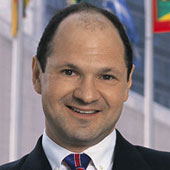America — A Warrior Nation?
Despite the tough image, is the United States up for a prolonged war against terrorism?
September 30, 2001
This picture seems to be confirmed by facts. Americans have the best-armed civilian population in the world. Their right to bear arms is guaranteed by the U.S. Constitution and jealously guarded by the National Rifle Association, one of the most powerful Washington lobby groups. Nearly 40% of Americans own guns — and over 10,000 people die each year of gunshot wounds.
With such a well-armed population, can it be a surprise that America is the world’s only remaining military superpower? It has 1.5 million men and women in uniform, a massive nuclear arsenal and military bases all over the globe. Its military has the capability to fight two regional wars at the same time — and its Navy is the only one which can still conduct military operations on two oceans simultaneously.
Many Americans responded to the terrible events of September 11 with tough talk and bluster. President George W. Bush has talked of capturing terrorist mastermind Osama bin Laden dead or alive, invoking cowboy movies and Wild West outlaws. Bumper stickers have proliferated with statements such as “God May Have Mercy — We Won’t” spelled out against the red, white and blue background.
But the movie image of Sylvester Stallone with an M-16 assault rifle in hand doesn’t necessarily mean that Americans are a warrior nation. In fact, it may be the other way around, as America’s love for TV and movie violence may prove.
Historically, people who encountered blood and guts in their everyday life have tended to shun it in their art. The ancient Greeks, for example, banned any vivid violence from their theater.
Europeans in the seventeenth century, having decimated their population in the bloody Thirty Year War, liked to relax to the sounds of Baroque opera, in which male heroes were sung by countertenors. Radical Muslim fundamentalists, for that matter, object to any portrayal of human form, violent or not.
As a matter of fact, seen from the inside American society appears remarkably peaceful, even by the standards prevailing in Western Europe. Among middle-class families, which make up the bulk of Middle America, many parents do not allow their children to play with toy guns. Fights among school age boys are rare. Aggressive adolescent impulses are carefully channeled into sports.
As it turns out, the forces that make many other nations so eager to fight don’t exist in America. Democracy diffuses bitter ideological disputes. Religious tolerance keeps violent fanaticism at bay. America’s history as a melting pot reduces ethnic and racial strife. Finally, since the overwhelming majority of Americans are descendents of immigrants, there is no historically rooted suspicion of outsiders.
In fact, immigrants flock to the United States precisely because they want to escape the ancient hatreds and wars that tear apart their own homeland. Here they want to work, to educate their kids, to pay their mortgages.
The peaceful nature of America was well understood by the Founding Fathers. From the country’s very beginnings, they limited the President’s ability to wage war by giving the U.S. Congress control over the country’s purse strings. Separation of powers also means that all executive orders issued during a national emergency must pass a strict constitutional test.
President Calvin Coolidge once said that the business of America is business. And that is why when Americans do fight, they approach fighting as a job — not a way of life. This is also why Americans are so intolerant of their casualties.
It is also the reason why America’s military is so enamored of high-tech gadgets of every kind and spends billions developing and acquiring new, sophisticated technologies: to avoid putting real-life Americans into “harm’s way.”
This high-tech, highly professional and well-armed military is very good at fighting other organized armies, such as the one used by Iraq’s Saddam Hussein. During the 1991 Gulf War, the Iraqi leader promised to stage “the mother of all battles” — only to see his troops quite literally being walked over by a U.S.-led military force.
And the United States is not alone. Armies in industrialized countries are constantly becoming more sophisticated, stronger — and more professional. Yet, increasingly, they are being defeated or fought to a standstill by bands of irregulars.
Over the past three decades, a disturbing pattern has emerged. Russians lost a war in Afghanistan — and are grappling with a seemingly unwinnable conflict in Chechnya. Israelis increasingly realize that they may never be able to put down the Palestinian uprising.
If America is to defeat global terrorism and prevent the September 11 atrocities from ever recurring, it will have to do so by taking this pattern into account. Most important, U.S. policymakers must make a realistic assessment of America’s own fighting spirit and determination to engage in a long-term conflict.
